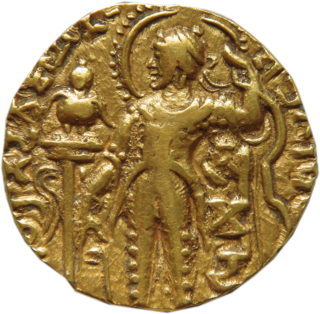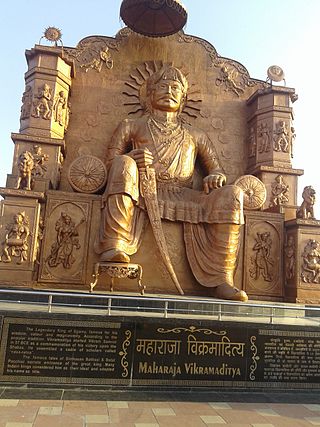Related Research Articles

Chandragupta Maurya was the founder of the Maurya Empire, a geographically-extensive empire based in Magadha. He reigned from 320 BCE to 298 BCE. The Magadha kingdom expanded to become an empire that reached its peak under the reign of his grandson, Ashoka the Great, from 268 BCE to 231 BCE. The nature of the political formation that existed in Chandragupta's time is not certain. The Mauryan empire was a loose-knit one with large autonomous regions within its limits.
The Gupta Empire was an ancient Indian empire which existed from the early 4th century CE to early 6th century CE. At its zenith, from approximately 319 to 467 CE, it covered much of the Indian subcontinent. This period is considered as the Golden Age of India by historians. The ruling dynasty of the empire was founded by Gupta, and the most notable rulers of the dynasty were Chandragupta I, Samudragupta, Chandragupta II and Skandagupta. The 5th-century CE Sanskrit poet Kalidasa credits the Guptas with having conquered about twenty-one kingdoms, both in and outside India, including the kingdoms of Parasikas, the Hunas, the Kambojas, tribes located in the west and east Oxus valleys, the Kinnaras, Kiratas, and others.

Chandragupta II, also known by his title Vikramaditya, as well as Chandragupta Vikramaditya, was the third ruler of the Gupta Empire in India, and was one of the most powerful emperors of the Indian history.

Chandragupta I was a king of the Gupta Empire, who ruled in northern and central India. His title Maharajadhiraja suggests that he was the first emperor of the dynasty. It is not certain how he turned his small ancestral kingdom into an empire, although a widely accepted theory among modern historians is that his marriage to the Licchavi princess Kumaradevi helped him extend his political power. Their son Samudragupta further expanded the Gupta empire.

Samudragupta (Gupta script: Sa-mu-dra-gu-pta, was the second emperor of the Gupta Empire of ancient India, and is regarded among the greatest rulers of India. As a son of the Gupta emperor Chandragupta I and the Licchavi princess Kumaradevi, he greatly expanded his dynasty's political and military power.

Sanchi is a Buddhist complex, famous for its Great Stupa, on a hilltop at Sanchi Town in Raisen District of the State of Madhya Pradesh, India. It is located, about 23 kilometers from Raisen town, district headquarter and 46 kilometres (29 mi) north-east of Bhopal, capital of Madhya Pradesh.

Kumaragupta I was an emperor of the Gupta Empire of Ancient India. A son of the Gupta emperor Chandragupta II and Queen Dhruvadevi, he seems to have maintained control of his inherited territory, which extended from Gujarat in the west to Bengal region in the east.

The Gupta script was used for writing Sanskrit and is associated with the Gupta Empire of the Indian subcontinent, which was a period of material prosperity and great religious and scientific developments. The Gupta script was descended from Brāhmī and gave rise to the Śāradā and Siddhaṃ scripts. These scripts in turn gave rise to many of the most important Indic scripts, including Devanāgarī, the Gurmukhī script for Punjabi, the Bengali-Assamese script and the Tibetan script.

Bindusara, also Amitraghāta or Amitrakhāda or Amitrochates was the second Mauryan emperor of Magadha in Ancient India. He was the son of the dynasty's founder Chandragupta and the father of its most famous ruler Ashoka. Bindusara's life is not documented as well as the lives of these two emperors: much of the information about him comes from legendary accounts written several hundred years after his death.

The Maurya Empire was a geographically extensive Iron Age historical power in South Asia based in Magadha. Founded by Chandragupta Maurya in 322 BCE, it existed in loose-knit fashion until 185 BCE. The empire was centralized by the conquest of the Indo-Gangetic Plain; its capital city was located at Pataliputra. Outside this imperial centre, the empire's geographical extent was dependent on the loyalty of military commanders who controlled the armed cities scattered within it. During Ashoka's rule the empire briefly controlled the major urban hubs and arteries of the Indian subcontinent excepting the deep south. It declined for about 50 years after Ashoka's rule, and dissolved in 185 BCE with the assassination of Brihadratha by Pushyamitra Shunga and foundation of the Shunga dynasty in Magadha.

The Indo-Greek Kingdom, or Graeco-Indian Kingdom, also known historically as the Yavana Kingdom (Yavanarajya), was a Hellenistic-era Greek kingdom covering various parts of modern-day Afghanistan, Pakistan and northwestern India. This kingdom was in existence from c. 200 BC to c. 10 AD.

Skandagupta was a Gupta Emperor of India. His Bhitari pillar inscription suggests that he restored the Gupta power by defeating his enemies, who may have been rebels or foreign invaders. He repulsed an invasion by the Indo-Hephthalites, probably the Kidarites. He seems to have maintained control of his inherited territory, and is generally considered the last of the great Gupta Emperors. The Gupta genealogy after him is unclear, but he was most probably succeeded by Purugupta, who appears to have been his younger half-brother.

Patna, the capital of Bihar state, India, is one of the oldest continuously inhabited places in the world and the history of Patna spans at least three millennia. Patna has the distinction of being associated with the two most ancient religions of the world, namely, Buddhism and Jainism. The ancient city of Pataliputra was the capital of the Mauryan, Shunga, and Gupta Empires.

The Udayagiri Caves are twenty rock-cut caves near Vidisha, Madhya Pradesh primarily denoted to Hindu gods Vishnu and Shiva from the early years of the 5th century CE. They contain some of the oldest surviving Hindu temples and iconography in India. They are the only site that can be verifiably associated with a Gupta period monarch from its inscriptions. One of India's most important archaeological sites, the Udayagiri hills and its caves are protected monuments managed by the Archaeological Survey of India.
The Western Satraps, or Western Kshatrapas were Indo-Scythian (Saka) rulers of the western and central parts of India, between 35 and 415 CE. The Western Satraps were contemporaneous with the Kushans who ruled the northern part of the Indian subcontinent, and were possibly vassals of the Kushans. They were also contemporaneous with the Satavahana (Andhra) who ruled in Central India. They are called "Western Satraps" in modern historiography in order to differentiate them from the "Northern Satraps", who ruled in Punjab and Mathura until the 2nd century CE.

The Vakataka dynasty was an ancient Indian dynasty that originated from the Deccan in the mid-3rd century CE. Their state is believed to have extended from the southern edges of Malwa and Gujarat in the north to the Tungabhadra River in the south as well as from the Arabian Sea in the west to the edges of Chhattisgarh in the east. They were the most important successors of the Satavahanas in the Deccan and contemporaneous with the Guptas in northern India.

Vikramaditya was a legendary king mentioned in ancient Indian literature, featuring in traditional stories including those in Vetala Panchavimshati and Singhasan Battisi. Many describe him as ruler with his capital at Ujjain. "Vikramaditya" was also a common title adopted by several monarchs in ancient and medieval India, and the Vikramaditya legends may be embellished accounts of different kings. According to popular tradition, Vikramaditya began the Vikrama Samvat era in 57 BCE after defeating the Shakas, and those who believe that he is based on a historical figure place him around the first century BCE. However, this era is identified as "Vikrama Samvat" after the ninth century CE.

The iron pillar of Delhi is a structure 7.21 metres high with a 41-centimetre (16 in) diameter that was constructed by Chandragupta II, and now stands in the Qutb complex at Mehrauli in Delhi, India. The metals used in its construction have a rust-resistant composition. The pillar weighs more than six tonnes and is thought to have been erected elsewhere, perhaps outside the Udayagiri Caves, and moved to its present location by Anangpal Tomar in 11th century.

The Gadhwa Stone Inscriptions, or Garhwa Stone Inscriptions, are early 5th-century CE Sanskrit inscriptions discovered in Uttar Pradesh relating to a series of charitable donations to various sattra (almshouses) by Gupta Empire rulers Chandragupta II and Kumaragupta I. The inscription is notable for including symbols for numerals "8, 10, 80 and 90" in the 5th-century, as well as mentioning the ancient city of Pataliputra.

Gupta art is the art of the Gupta Empire, which ruled most of northern India, with its peak between about 300 and 480 CE, surviving in much reduced form until c. 550. The Gupta period is generally regarded as a classic peak and golden age of North Indian art for all the major religious groups. Gupta art is characterized by its "Classical decorum", in contrast to the subsequent Indian medieval art, which "subordinated the figure to the larger religious purpose".
References
- 1 2 3 4 5 6 7 Sharma, Tej Ram (1978). Personal and Geographical Names in the Gupta Inscriptions. Concept. p. 378.
- ↑ Agrawal, Ashvini (1989). Rise and Fall of the Imperial Guptas. Motilal Banarsidass Publishers. p. 5. ISBN 8120805925.
- ↑ Cotterell, Arthur (30 June 2011). The Pimlico Dictionary Of Classical Civilizations (E-book ed.). Random House. p. 496. ISBN 9781446466728.
- ↑ "UNIT 2 ECONOMY, SOCIETY, CULTURE Guptas AND POLITY: THE GUPTAS" (PDF). Ekgyankosh AC. Ekgyankosh AC. Retrieved 4 January 2021.
- ↑ Ibid., pp.25-26.
- ↑ कौत्सश्शाब इति ख्यातो वीरसेन: कुलाख्यया । शब्दार्थ-न्याय-लोकज्ञ कवि पाटलिपुत्रक ॥